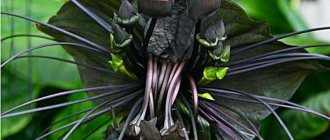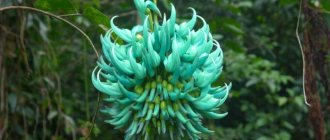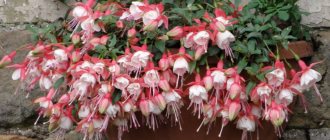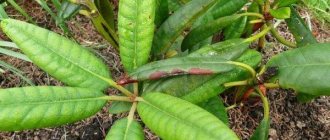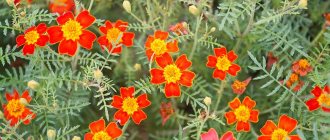The most interesting plants of the world: description, photo
The most interesting plants in the world:
The most interesting plants of the world - Amorphophallus titanica
Amorphophallus titanica - the birthplace of this miracle of nature is Sumatra. Unfortunately, such an interesting specimen is practically never found in nature. People have completely exterminated the plant, and are now trying to increase the amount of Amorphophallus by growing it in specialized botanical gardens. And it bears fruit. With proper and proper care, the plant grows up to 3 meters in height. But all this beauty has one significant drawback - during flowering, the plant emits a fetid odor of rotting flesh. For this reason, locals call the flower the corpse lily.
The most interesting plants in the world - Venus flytrap
The Venus flytrap is a carnivorous plant that feeds on small insects. The bright color serves as a kind of bait for insects; it attracts them from afar and does not allow them to fly past. When an insect approaches, the plant begins to emit a specific smell, which also increases the desire to get closer to the flower. But as soon as the insect lands on the leaves, they close as tightly as possible and do not release the victim. After this, the flycatcher spends 10 days digesting its prey.
The most interesting plants in the world - Victoria Amazonica
Victoria Amazonica is the largest water lily in the world. Although outwardly it looks very fragile, it can withstand weight up to 80 kg. On the outside of the huge sheet there are a large number of ribs that enhance the natural fabric. There are also thorns on the leaves of the plant, which prevent the herbivorous inhabitants of our planet from using it as food. Thorns are a kind of protection, thought out by Mother Nature herself. Another feature of this interesting plant is the slightly curved edges of the leaves. This is what gives it the ability to float well on the surface of the water.
The most interesting plants in the world - Bloody tooth
Bloody tooth is an interesting plant that is nothing more than a mushroom, albeit inedible. It can be found in America, Australia and some European countries. It does not have poisonous qualities, but it should not be eaten. And all because the mushroom has a pronounced bitter taste, which cannot be completely removed even with heat treatment and soaking. But still, people sometimes use it in folk recipes to treat skin diseases. The pulp of the mushroom has antibacterial properties, which helps disinfect small wounds and scratches.
The most interesting plants in the world - Euphorbia obese
Euphorbia obese is a succulent that takes up to 2 years to complete its development cycle. If you want to start breeding it at home, remember that the plant is bisexual. This means that the male and female flowers bloom on two different specimens. After pollination, the plant produces a fruit filled with seeds. When it is fully ripe, it spontaneously explodes and releases its seeds. This interesting plant is pollinated in the standard way - with the help of insects. In nature, the plant grows in rocky areas. Prefers places that are partially shaded from the sun.
Crocus
A delicate flower that blooms at the very beginning of spring. The blooming of crocuses means that winter is over and summer will soon come. In addition to spring varieties, there are autumn types of crocuses that can bloom until December.
Crocus is not only an amazingly beautiful flower, but also the most expensive spice, which is known as saffron; it has an unforgettable taste and aroma. Not all types of crocus can be used as spices. “Saffron sativa” is suitable for these purposes. In nature, this plant can be found in the Middle East, South Asia and Mediterranean countries.
Crocus is a perennial plant and belongs to the Iris family. Some types of flowers can be grown in garden plots in central Russia. It is a bulbous plant with straight, narrow leaves and a single flower. In rare cases, 2 or 3 buds may appear from one bulb.
Saffron stigmas are used to make spices. Crocus is not only a tasty, but also a healthy flower. Since ancient times, people have used saffron-based tinctures and ointments. It improves the condition of the nervous system, restores vision and rejuvenates the skin. In addition, the flower is considered an excellent aphrodisiac; it is able to restore sexual function in both men and women.
Strange plants of the world: description, photo
Strange plants of the world:
The strangest plants in the world - Momordica charantia
Momordica charantia is an annual herbaceous vine from the Cucurbitaceae family. This interesting plant is native to Asia. Depending on the place of growth, the name may change. Momordica is often called Chinese pumpkin, bitter cucumber, Indian pomegranate . The plant is unique in that during the ripening process it changes its taste.
When it is completely green, it has a taste similar to the cucumber we are used to. When half-ripe, the plant becomes bitter and begins to emit a pumpkin-like aroma. When it ripens, the flesh turns red and becomes sweet. At the moment, breeders have been able to develop varieties that produce fruit in our latitudes, although the plant feels best in a greenhouse.
The strangest plants in the world - Puya Raymonda
Puya Raymonda is a relative of the aromatic pineapple. The plant grows in mountainous areas because it loves cool weather. Moreover, it can easily tolerate sub-zero temperatures at night. Nature made sure that the plant easily tolerates adverse weather conditions. During the day, its pulp produces a substance similar in composition to antifreeze, and when the temperature drops below zero, it begins to act. Puya Raymonda is also unique in that it blooms once every 150 years.
Under favorable conditions, it can bloom even after 80 years. Its inflorescence consists of 10,000 flowers, which ultimately produce more than 11,000,000 small seeds. When the plant blooms, it looks like a flowering column with insects swarming around it.
The strangest plants in the world - Carnegia gigantea
Carnegia gigantea is a prominent representative of the cactus family. Grows in desert areas of Arizona and California. In nature, there are specimens whose height is more than 20 meters. These tree-like cacti live a fairly long life - at least 150 years. For approximately 100 years, the cactus grows in height, and only after reaching its maximum height does it begin to bloom and bear fruit.
And the closer the plant is to the source of moisture, the more fruits appear on it. If there is no source of moisture, Carnegia lives in saving mode. During the rainy period, it accumulates moisture in its pulp and then gradually uses it. People use cactus fruits for food, and dense needles instead of sewing needles.
Strange Plants of the World - Prickly Pear Bigelow
Prickly Pear Bigelow is another plant in the Cactus family. This “airy” representative of the flora from a distance resembles a fluffy bush, and only when approaching it can you understand that the plant is covered with not very large thorns. True, in nature there are also more massive representatives, reaching a height of up to 2 meters. They, accordingly, have larger spines - 2 cm.
When the cactus blooms, it becomes even more attractive. Its fluffy branches are covered with bright, red and green flowers. This species has also adapted to dry periods, and therefore accumulates moisture from the air during temperature changes.
Strange plants of the world - Porcupine tomato
Porcupine toma t is a prominent representative of Madagascar. True, this is not the plant that we grow in our garden plots. In Madagascar, it is considered a weed that can quickly grow over large areas. The most annoying thing for people is that it is not afraid of chemicals. After treatment, it fades only slightly, but literally within a day it resumes its growth.
Also, he is not particularly afraid of low temperatures. People have to fight it exclusively by eradication. But there are problems here too. The plant is covered with poisonous thorns, the poison of which causes allergies in humans. Therefore, most often it is first cut off closer to the root, and only then carefully removed from the site.
Peony
Peony is the most beautiful flower that can be grown in the garden. In nature, it is distributed in the subtropics, as well as in temperate regions of North America, Europe and Asia. This is a perennial plant with large rhizomes, powerful stems and gorgeous flowers. Peony can reach a height of up to 1 m. The diameter of the flowers is 25 cm.
This beautiful plant not only has exquisite beauty, but is also a medicine. A tincture is made from peony, which is used to restore the nervous system, improve the functioning of the liver and stomach. Its healing properties have been known since ancient times, and the flower received its name in honor of the mythical doctor Peon.
The ancient Greeks were sure that a magic flower was able to protect a person from evil spirits. For protection, they wore jewelry made from peony roots. Warriors of Ancient Rome, going into battle, tried to carry with them pieces of the plant, which were attributed with miraculous properties.
In China, a peony festival is held every year. Millions of tourists gather for this event, and special “peony tours” are organized in the city of Luoyang, where the festival takes place. At this time, the city hosts concerts, scientific conferences and exhibitions dedicated to the king of flowers - the peony.
Poisonous plants of the world: description, photo
Poisonous plants of the world:
Poisonous plants of the world - Common wolfberry
Common wolfberry - at first glance it may seem that these are just beautiful berries, some even try to taste them. The scientific name of this poisonous plant is Daphne. The shrub looks very attractive in appearance - dark green leaves and many red, juicy berries. The height of the plant can reach 2 m. The berries themselves are very poisonous, they provoke strong salivation, a burning sensation in the mouth and throat.
And when they enter the gastrointestinal tract, they provoke severe diarrhea, nausea, and vomiting. Literally 3 consumed berries can cause death. Even the juice from the berries is harmful to humans - it provokes burns and allergic reactions. If the juice is not quickly removed from the skin, ulcers may develop.
Poisonous plants of the world - Aconite
Aconite - at first glance in the photo, it’s just a beautiful wild flower, which was created to be admired. But those who live in the places where it grows know that it is better to bypass this beauty and not touch it at all. If you try to cut it or simply rub the leaves in your hands, you will thereby provoke an allergy on the skin. And this is the most harmless consequence that can be obtained from contact with this plant.
If its juice gets into an open wound or on mucous membranes, then very soon you will feel a headache, a burning sensation in the stomach and aching in the limbs . True, our ancestors still used the poisonous properties of the plant for their own purposes. They treated arrowheads with its juice, and this helped them paralyze the muscles of animals.
Poisonous Plants of the World - Crow's Eye
Crow's eye four-leaf is a plant that is very often used in folk medicine. Herbalists consider it an excellent remedy in the fight against various neoplasms. But as practice shows, people very often increase their dose of medication, and thereby worsen their condition. A large amount of toxic substances enter the body, and this causes seizures and headaches. Problems with the cardiovascular system may also occur , and this can be fatal.
Poisonous Plants of the World – Rosary Pea
Rosary pea is a very beautiful plant that people use to make decorative ornaments. To be more precise, beads, earrings and bracelets are made from it. Have you already imagined how beautiful it will all look? Before buying such dyes, weigh the pros and cons. Initially, picked peas are very poisonous. They contain abrin poison, which can kill a person in a short time.
Manufacturers of such jewelry claim that they process peas in a special way, which makes them safe for women. But as practice shows, even the special coating wears off over time, and the berries begin to gradually poison the body.
Poisonous plants of the world - Belladonna
Belladonna is another beautiful and at the same time poisonous plant. Many will say that this plant is widely used in medicine. Yes, for example, eye drops are made from it. But the dose of the active substance in them is so small that it cannot harm the body. But if you eat a couple of berries of this poisonous plant, you will probably be very poisoned.
If a small dose of toxic substances enters the body, you will end up with dry mouth and dizziness. If the dose is large, you may experience breathing problems, hallucinations, and very strong convulsions similar to an epileptic seizure. If such symptoms are present, it is necessary to urgently cleanse the stomach and carry out the most thorough cleansing of the entire body. If this is not done in time, death is possible.
Beautiful plants of the world: description, photo
Beautiful plants of the world:
Beautiful plants of the world - Japanese Sakura
Japanese Sakura is something other than the cherry tree we all know. True, unlike the varieties growing on our territory, it is not used as food. The fruits of this beautiful tree do not have good taste, which is why in Japan it is grown exclusively for decorative purposes. The uniqueness of this tree is that it can bloom not only in summer and spring, but also in winter. For the Japanese, sakura is a symbol of their country, because when it blooms, everyone strives to visit the gardens where it grows.
Also, for the wise Japanese, Sakura is direct proof that youth and beauty are not eternal, but fleeting. They have a legend about this beautiful plant. The grandson of the Sun goddess was supposed to marry the eldest daughter of the god Horus. But instead he chose the youngest. Their marriage was approved, but as punishment for disobeying their parents, they made the two lovers ordinary earthly people. For the gods, their love is like a sakura flower, very beautiful, but at the same time has no chance of eternal existence.
Beautiful plants of the world - Chinese Lotus
Chinese Lotus is a perennial plant that thrives floating on water. The color of lotus inflorescences varies - white, red, pink, light burgundy. The flower is unique in that it is always turned towards the sun. The Chinese call it that - the flower of the sun. When the sun shines on the petals of the plant, you can notice a slight pearlescent sheen.
In China, this beautiful plant is considered the guardian of human souls. The Chinese believe that the soul of all righteous people finds peace in these flowers, so that they can continue to enjoy life in peace and quiet. It is believed that if a lotus remains fresh and beautiful longer than usual, it means that the soul of a holy person has entered into it.
Beautiful plants of the world - Peonies
Peonies are a beautiful plant that can be found in our gardens everywhere. Therefore, in most cases we treat it with indifference. But in nature there are specimens that can really surprise. Peonies growing in the subtropics, as well as in America and Asia, have a more developed root system, which contributes to the formation of a larger bud. Such species can grow to a height of more than 1 meter.
Peonies have been valued by people at all times. Medicinal infusions were made from them to treat nerves. People also believed in the magical properties of this beautiful plant. Our ancestors believed that when dried, the plant could protect against evil spirits. Due to this oprichnina, they almost never parted with him.
Beautiful plants of the world – Crocus
Crocus is a very beautiful plant that we associate with the arrival of warmth. These are one of the first flowers to bloom after the snow cover disappears from the ground. There are also varieties that perform well even in slightly sub-zero air conditions. Provided there are no severe frosts, they can bloom until December.
Crocus is also the vibrant spice we know as saffron. More precisely, these are the stigmas of the inflorescence. True, all varieties are not suitable for preparing spices. Breeders developed saffron , and it is used to make the most expensive spice in the world. In the wild, this beautiful plant is distributed in South Asia and the Mediterranean.
Beautiful plants of the world - Dahlia
Dahlia is another plant that is very familiar to us. Gardeners love this flower, which is why it can be seen in almost every garden. Now there are a large number of varieties, but the most popular are terry. They look very attractive and bloom longer. This beauty was brought to Russia by the German ethnographer Ivan Georgi, and the flower was named after him.
Japanese sakura
The beautiful tree, which is a symbol of Japan, is called sakura. The first mention of a flowering tree is shrouded in a beautiful legend. The god Horus invited the grandson of the Sun goddess to choose one of his daughters as his wife. The young man's name was Nigigi. The eldest girl, named High Rock, was supposed to receive eternal life as a dowry, but Ninigi decided to marry the youngest daughter, whose name was Blooming. For this, God gave their offspring a wonderful, but very short life, the same as cherry blossoms.
Since then, cherry blossoms have served as a reminder to people that beauty is temporary, and life is not endless. The flowering of the tree lasts only one week. At this time, Japan celebrates the Hanami holiday, which translated means contemplation of flowers. Famous people, famous politicians and representatives of the imperial family take part in the ceremonial events.
Sakura is a Japanese cherry tree. Most varieties of this tree are grown for decorative purposes. Beautiful cherries can delight people only with their flowers; the fruits, if any, are small and absolutely unsuitable for consumption. Besides Japan, cherry blossoms can be seen in the Himalayas, China and Korea. The trees growing on the southern island of Okinawa are the first to begin to bloom. Their flowering begins in January. Depending on the variety, sakura can bloom not only in winter; some species bloom in spring and autumn.
Rare plants of the world: description, photo
Rare plants of the world:
Rare plants of the world - Red Camellia
Red Camellia - This rare flower is a close relative of the rose. More precisely, this is one of the rare varieties of roses. Previously, these beautiful flowers were distributed throughout China. But their beauty was so attractive that the buds were cut off en masse, which led to the almost complete disappearance of the variety. When roses were on the verge of extinction, the English florist John Meddlemist saw them.
He managed to persuade the owners to sell him a small bush, which he brought home. John managed to root the bush and it even began to produce shoots, which he sold to everyone. True, over time, these specimens also stopped reproducing normally, so at the moment the Red Camellia can only be found in private greenhouses; it will no longer grow in the wild.
Rare plants of the world – Kokyo
Coquio is another rare plant that can be seen in private greenhouses. The birthplace of this natural wonder is Hawaii, and it was here that such beauty was first discovered. But even at the time of discovery, the unique tree was not numerous. Even then, scientists realized that it needed to be protected and propagated. But, unfortunately, they did not succeed, and already in the middle of the 20th century they had to announce that such beauty no longer existed on our planet.
But after 20 years, people again found one copy, although it suffered a disappointing fate. Kokyo died in a fire. After some time, a sprout appeared in this place, which was transferred to the greenhouse and began to be propagated. At the moment, the number of trees with red flowers is increasing all the time.
Rare plants of the world - Clianthus
Cleanthus - back in 1884, this beauty was included in the category of rare plants. Initially, people could not understand the reason for the decrease in the amount of this beauty. The best conditions were created for Klianthus, but it still did not bear fruit. Then we found out that only the sunbird can pollute the plant. Unfortunately, such an insect no longer lives on our planet. Scientists, of course, are trying to dust Clianthus artificially, but this does not give any results. It is likely that very soon this beauty will disappear forever.
Rare plants of the world - Phantom Orchid
Ghost Orchid - Fans of this rare plant know how difficult it is to see it bloom. When the time for flowering comes, one snow-white flower appears on the stem. But it also blooms only so that reproduction becomes possible. True, pollination occurs very rarely, because the plant is on the verge of extinction. The reason for this situation is that only butterflies can do this. And they are known to love rich aromas. But the orchid has such a weak aroma that it does not attract insects. And these butterflies are found more often in Florida, USA.
Rare plants of the world - Black bat
Black bat - the birthplace of the plant is China, Thailand, Burma. True, everywhere this representative of the flora is considered endangered. Takka Chantrier (scientific name) is a very beautiful plant, the flowers can have herbal, burgundy, chocolate, or eggplant colors. Up to 12 buds can bloom on one stem at the same time. But this plant has one significant drawback. The most favorable conditions are important for him. If the plant does not have enough moisture or warmth, it simply does not bloom. It also does not like large amounts of ultraviolet radiation. All this leads to the fact that flowers appear very rarely, and this reduces the likelihood of the formation of new specimens.
Dangerous plants of the world: description, photo
Dangerous plants of the world:
Dangerous plants of the world - Buttercup
Buttercup - we all know this flower under the name night blindness. Often our grandmothers frightened us with the fact that those who pick the yellow inflorescence will definitely go blind. And no matter how sad it was to admit it, they were partially right. This plant is dangerous for humans. If the plant juice gets into the eyes, it will provoke severe vasospasm, and as a result, temporary blindness. The plant also has a detrimental effect on the respiratory system. Upon contact with the juice of the flower, a cough appears, and in particularly severe cases, swelling of the larynx may develop.
Dangerous plants of the world - Oleander
Oleander is a very beautiful, but at the same time dangerous plant for humans. Grows in the tropics and subtropics. There it is used to decorate garden plots. But at the same time, everyone knows one important rule - you need to wear protective gloves and goggles when working near bushes. If the juice of the plant gets into an open wound or on mucous membranes, then the heart rhythm will fail and, as a result, problems with blood pressure. With a large concentration of a toxic substance in the body, death can occur.
Dangerous plants of the world - Hogweed
Hogweed is a plant familiar to many of us. And if earlier it could be found exclusively in abandoned villages, now it is actively affecting large cities. The fact is that this plant is not particularly whimsical, and therefore multiplies quite quickly, infecting more and more new territories. The danger of Hogweed is that it can cause serious burns. And if the plant sap is exposed to sunlight, large blisters may appear. For this reason, the poisonous juice must be immediately washed off the skin with cool running water.
Dangerous plants of the world - castor bean
Castor bean is a dangerous plant that grows in the tropics and subtropics. There it is found both in the wild and in home greenhouses. What is the danger then, you ask? The leaves and stems of the plant are not dangerous to humans; moreover, useful castor oil is extracted from them. But the seeds contain the toxic substance ricin. And if you accidentally swallow the change, it can cause death.
Dangerous plants of the world - Euphorbia
Euphorbia - this type of dangerous plant includes many different specimens. These include cacti, succulents, and ordinary indoor flowers. As a rule, when the leaves are torn off or the stem is damaged, all of them begin to secrete a white liquid, visually similar to milk. It is this juice that is dangerous for humans. If it is swallowed, it will cause severe food poisoning. Upon contact with skin, the juice causes burns.
